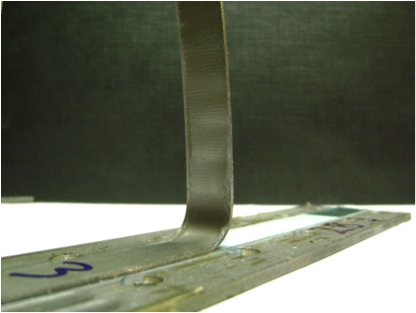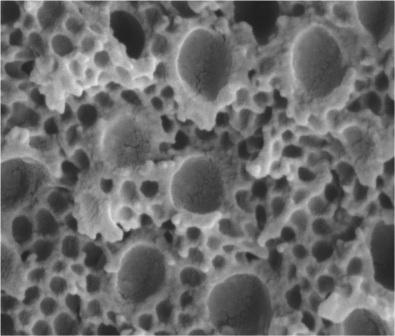Fracture Toughness Characterisation of Structural Adhesives
Research
- CCM-bond
- Bacterial Adhesion
- Fracture Toughness Characterisation of Structural Adhesives
- Continuum Damage Models for Toughened Epoxy Adhesives
- An Investigation of Composite-to-Composite Bonding
- Characterisation of Traction-Separation Laws in Structural Adhesives
- Science and Engineering of Advanced Composites (SEAC)
- Research Facilities
- Collaborators
- Research Vacancies
- Mixed Mode
- CompSim
Previous research by the UCD adhesives group has found that the fracture toughness (GIC) of nano-toughened structural adhesives, measured by standard (British Standard BS 7991-2001) TDCB tests, is strongly dependent on the bond gap thickness and the width of the specimen. These factors influence the three-dimensional state of stress (and hence the degree of constraint) in the vicinity of the crack tip. By a combination of numerical modeling, SEM microscopy (e.g. Figure 1) and experimental studies a relationship between crack tip constraint and void growth has been established that agrees with the Rice-Tracey void growth model.

Figure 1: SEM image of cavitation caused by nano particles.
The goal of this project is to further investigate this relationship. In collaboration with Henkel a custom adhesive formulation has been developed whereby nano-particle void growth is the dominant toughening mechanism. This adhesive will be examined with a variety of experimental setups. These include the circumferentially deep notched tensile (CDNT) test, which allows adhesive properties to be investigated at wide range of different constraints; standard TDCB testing, which characterises the adhesive at a range of bond widths and thicknesses; and peel tests (see Figure 2), which are popular in industry but as yet do not provide a robust measurement of toughness. Ultimately, the fracture toughness of an adhesive under given conditions should be a material property which may be used in engineering design. A central aim of this project is the comparison or transferability of fracture toughness measurements between different test geometries and the recommendation of the most suitable test procedure(s) for the characterisation/classification of different adhesives.

Figure 2: Fixed arm peel test specimen.
Sponsors:
- Embark Initiative - (opens in a new window)website
- Henkel Loctite Ireland Ltd. - (opens in a new window)website
Contact details:
- Prof. Alojz Ivankovic (opens in a new window)alojz.ivankovic@ucd.ie